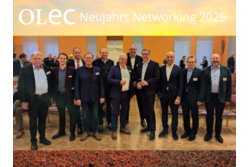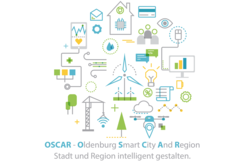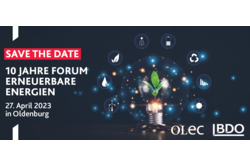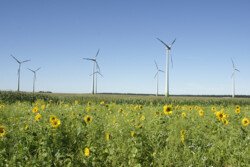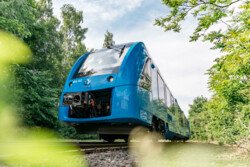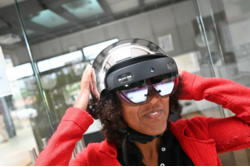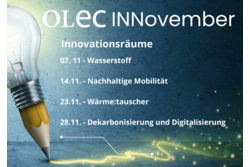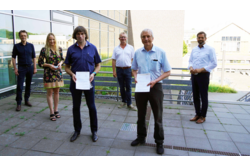
Lower Saxony's Environment Minister Olaf Lies presented funding decisions totaling more than 3.6 million euros to Osnabrück University of Applied Sciences and the mechanical engineering company Kalverkamp.
A completely new agricultural vehicle concept powered by green hydrogen: Prof. Dr. Hans-Jürgen Pfisterer of Osnabrück University of Applied Sciences and Klemens Kalverkamp, Managing Director of the mechanical engineering company Kalverkamp in Rieste, Germany, have now received funding decisions totaling more than 3.6 million euros from Lower Saxony's Environment Minister Olaf Lies. "Clean hydrogen, along with electricity from wind and photovoltaics, is becoming the fuel for the energy transition and climate protection," Lies said during the handover at Osnabrück University of Applied Sciences. "Particularly in agriculture, which is already struggling with the effects of climate change, promising solutions have a special beacon character. They can act as role models for other regions. NeXaT2H2 demonstrates the use of green hydrogen in agriculture in an exemplary manner and is an important step on our way to becoming the number one hydrogen country," Lies said.
Such innovations would not only advance the energy transition, he added. "Because wherever we succeed in permanently establishing such innovation drivers, they will also have a magnetic effect on other industrial settlements. In this way, climate policy combined with smart innovation and industrial policy ensures that our location is well equipped with new industrial jobs to develop into a climate-neutral future."
The funded joint project is entitled "NeXaT2H2 - Demonstration of a hydrogen-powered farm vehicle." A prototype of Kalverkamp's NeXaT vehicle already exists. "It is a completely new and different vehicle concept that we designed from the outset for hydrogen use," Kalverkamp explains. The vehicle moves on four individually controllable belt drives, similar to an overhead crane, across farmland on narrow field paths. With the "wide span concept," it covers a width of up to 18 meters. Until now, however, this hybrid-electric prototype of the NeXaT vehicle has been powered by diesel. This is precisely what is set to change thanks to the research cooperation with Osnabrück University of Applied Sciences.
A technological basis for the widespread use of green hydrogen in agricultural technology
"The goal is to develop and integrate a hydrogen drive for the vehicle in the course of the project," says Pfisterer. To be able to do that, Pfisterer's research team is drawing on highly innovative preliminary work. "In 2020, we succeeded for the first time in simulating electric drive systems with very high model accuracy in real time," explains the professor of electric drives and fundamentals. "This allows us to optimize both the overall system and each individual component. We can couple the virtual and real worlds in the test lab because simulation and testing can be performed synchronously."
In other words, the collaborative research project is creating a digital twin of the fuel cell system, the power electronics, the electrical machines and the
measurement, control and regulation systems. This makes it possible to design and optimize the electric drive system. "With this first project of our hydrogen roadmap, we are laying a technological foundation here for the broad use of green hydrogen in agricultural technology," Pfisterer is convinced.
University President Prof. Dr. Andreas Bertram and Prof. Dr. Bernd Lehmann, Vice President for Research, Transfer and Promotion of Young Scientists, thanked Lies for the state's support of the joint project. "In many ways, this project has the potential to strongly change current land management towards greater sustainability, also internationally. We are very pleased that we, as Osnabrück University of Applied Sciences, can play an active role in shaping this transformation in agriculture and also play our part in consolidating and even expanding the high level of innovation in agricultural technology in the region."
Caption: Prof. Dr. Hans-Jürgen Pfisterer from Osnabrück University of Applied Sciences (front left) and Klemens Kalverkamp, Managing Director of the mechanical engineering company Kalverkamp (front right), received the funding notifications for the project "NeXaT2H2 - Demonstration of a hydrogen-powered agricultural vehicle" from Olaf Lies, Lower Saxony Minister for the Environment, Energy, Construction and Climate Protection (right). On site, university president Prof. Dr. Andreas Bertram (left), district administrator Anna Kebschull and Prof. Dr. Bernd Lehmann, vice president for research, transfer and promotion of young scientists, also exchanged ideas about the project.
Text and image: Osnabrück University of Applied Sciences
Further information:
Prof. Dr. Hans-Jürgen Pfisterer
Electrical Drives and Fundamentals
Phone: +49541/969-3664
E-Mail: j.pfisterer@hs-osnabrueck.de oder kommunikation@hs-osnabrueck.de
Translated with www.DeepL.com/Translator (free version)




